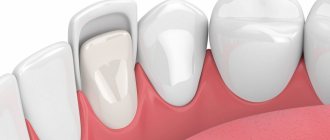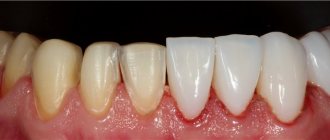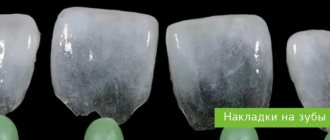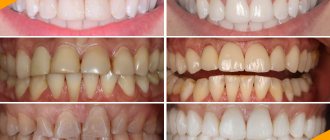DentalClinic dental specialists use modern types of prosthetics. Dental veneers are one of the most elegant ways to create a truly radiant smile. This type of prosthetics is only suitable if you have your own teeth. Veneers are ultra-thin plates that replace the front layer of teeth.
The technology allows you to restore enamel, correct chips, reconstruct the shape, hide the presence of large gaps between teeth, and give a rich white color and shine. The plates differ in thickness and manufacturing technology: composite and ceramic. Veneers in Krasnoyarsk at an affordable price - at DentalClinic. Specialists will select the appropriate type of prosthetics.
Indications for installation of veneers
So, you have decided to get veneers. This means you need an initial consultation with a dentist and examination. During the examination, the doctor determines whether there are indications for installation . Indications include:
- dark color of tooth enamel
- cracks, chips in teeth
- gap between front teeth
- defects of the front teeth (curvatures, short teeth, worn down teeth)
It is important to remember that veneers are only installed on treated teeth. The absence of caries, tartar, and gum disease is the main condition for installing veneers.
Veneers price
Veneers help correct serious defects: chips, irregular shapes, gaps between teeth. The technology allows you to create an ideal dentition. In DentalClinic dentistry, the price of veneers starts from 19,000 rubles. Specialists will select the appropriate material and installation method.
DentalClinic dentistry uses the most modern types of removable and fixed prosthetics. Each doctor on the team has extensive experience. Here, a treatment option is selected not out of commercial interest, but out of the real needs of the patient. You can find out which type of prosthetics is right for you and how much it will cost at a free consultation.
Call and make an appointment at DentalClinic by phone: +7 (391)-986-66-68 Komsomolsky Ave., 1a st. Yaryginskaya embankment 13 st. Telmana, 30a st. Urvantseva, 30, Chernyshevsky St., 77.
Types of veneers
Veneers are divided into composite (therapeutic) and orthopedic (indirect). They differ both in material and installation method, as well as in price, time and complexity of installation. Let’s figure out what the differences are between these types of veneers and in what case it is better to install them. Composite veneers are installed in one visit to the doctor. They are removed directly in the oral cavity using the direct method. The veneer material is similar to a filling, and the method of installation is similar to a filling. Initially, the dentist grinds down the front surface of the tooth, and then applies a light-curing material layer by layer. At the final stage, the veneer is ground and polished. Such veneers will last, like a regular filling, 5-7 years. The dentist will warn that composite veneers can still darken over time, so the patient is advised to minimize coloring foods.
If a composite veneer can be compared to a filling, then an orthopedic veneer can be compared to a crown. But the process of making a record is more complex and precise. This veneer is made from ceramic or zirconium dioxide. The process of installing it may resemble the process of installing a crown . Veneer installation is carried out by an orthopedic dentist in the following stages:
- Initially, the teeth on which veneers are ground down, removing a layer of up to 0.7 mm. The thickness of the layer depends on the shape and size of the tooth.
- Then impressions are taken of the ground teeth, from which veneers will be made.
- stage - fitting of finished records and color selection.
- the final stage is the installation or fixation of veneers with a special glue, which ensures a high degree of reliability of the adhesion of the veneer to the tooth.
Between the first and second stages 7-10 days pass. To prevent the patient from experiencing discomfort, the doctor will suggest temporary plastic veneers while the permanent ones are being made. Orthopedic veneers , thanks to the material and reliability of installation technology, will last 10-15 years and will be practically indistinguishable from natural teeth.
How we install veneers on teeth
To place veneers on teeth, you must first file down the tooth. Then, depending on the type of plate, the doctor either makes it on site right in the mouth, or takes an impression of the teeth and sends it to the laboratory for further production. This procedure takes several hours, and all manipulations are performed in one visit. That is, you do not have to come to the clinic several times for this.
We will select the appropriate type of veneer depending on the condition of the teeth. Typically, composites are used when only one or two teeth are damaged. If you need to update your entire dentition, you need to use ceramic veneers on your teeth, which are made in the laboratory.
Price
The price of therapeutic veneers is comparable to dental treatment - the cost of the material plus the work of the dentist. The price of an orthopedic veneer is an order of magnitude higher and consists of both the cost of the material and the cost of manufacturing in the laboratory, as well as the work of the orthopedic dentist who installs the veneer. Advice: before installing orthopedic veneers, ask the doctor to show photos of his work before and after. In any case, when choosing the installation method and veneer material, be guided primarily by the recommendations of your treating dentist.
I wish you health and brilliant smiles!
Ceramic veneers
Ceramic veneers are made only in a laboratory. The process is the same: the doctor grinds down the tooth, takes an impression and sends it to specialists, and installs a temporary veneer for the patient. When the permanent one is ready, the doctor installs it on the ground tooth using special cement. Before this, the color of the tooth is adjusted to the overall color of the dentition.
Porcelain veneers are usually used when you want to replace a large number of teeth. Such dentures are stronger than composite ones, and they last many times longer. Ceramic veneers are more expensive than composite veneers, but they need to be replaced less frequently. Therefore, the price may be equal or sometimes lower.
Installation of ceramic veneers in Krasnoyarsk
Ceramic veneers differ from composite veneers in their strength and long service life - 15 years or more. However, they are much more expensive than composite plates and require time to manufacture (approximately 2 weeks).
At the initial appointment, the dentist makes an impression of the tooth on which the ceramic veneer will be installed. The impression is sent to a dental laboratory , where a ceramic plate is made. After the veneer is made, the doctor prepares the corresponding tooth and fixes the product on it.
The advantages of ceramic veneers are:
- Long service life;
- High strength (they can be installed on chewing teeth);
- Resistance to staining;
- High density of adhesion to the patient’s own tooth tissue.
Disadvantages include: long production (need to wait), mandatory preparation of tooth enamel, higher cost.
What to do after installing a veneer
You should not forget about proper care of veneers after their installation, since this will largely determine their service life. They need to be cleaned at least twice a day, and ideally every time after eating. In addition, when caring for veneers, you can use dental floss or an irrigator. Rinsing with special lotions is also included in the list of mandatory care procedures. If you find suspicious spots, chips or other damage, if there is a change in the sensations from the presence of the veneer in the oral cavity, if you experience discomfort or other conditions, you should consult a doctor.
Veneers: what are they, types
Veneers are the thinnest overlays on teeth, invisible to surrounding microprostheses, which make it possible to correct external dental defects . After their installation, the smile becomes like that of a Hollywood star.
Veneers are made from composite materials and ceramics, depending on which they differ in terms of production and service life, installation method, characteristics and operating features. In addition, there is a type of onlays called lumineers , which are installed without grinding the patient’s teeth. Installation of lumineers requires significant material costs, so in most cases patients opt for less expensive, but no less aesthetic ceramic and composite options.
Composite veneers are installed in one visit to the dentist. Such structures will last about 4 years, after which they must be replaced. Their installation is carried out using a direct method, by simply gluing it to the surface of your own tooth. As a rule, this happens during one visit to a specialist.
Ceramic veneers are more durable; they will last about 15 years (with proper care). When installing them, the specialist uses an indirect option: ceramic veneers require taking an impression, as they are made in a special laboratory. Ceramic onlays are placed on the pre-treated tooth.
Frequently asked questions about veneers:
What problems can veneers correct?
Ceramic veneers mask chips, cracks in teeth, as well as their darkening or other discoloration, and close the gaps between them. Sometimes veneers are installed simply to make your smile a little more attractive.
Does installing veneers hurt?
No, installing veneers is a completely painless procedure. Before tooth enamel is removed, anesthesia is administered so you will not feel any pain or discomfort.
Will there be sensitivity after installing veneers?
Because veneers require the removal of a small portion of the enamel, the tooth may be sensitive for several days.
Can porcelain veneers change color?
No, ceramics do not change color over time. It is also worth noting that veneers are not amenable to whitening procedures.
Can veneers have caries?
Teeth with veneers, like regular teeth, can develop caries, but the veneers themselves cannot have caries. To prevent the development of tooth decay, you must brush and floss your teeth with veneers thoroughly and regularly, just like you would regular teeth.
What is the difference between a veneer and a crown?
Although a crown and veneer are usually made of the same material, they are used in very different ways. Veneers are intended for cosmetic purposes, while crowns are used to restore significantly damaged teeth. A veneer is a very thin piece of ceramic that is bonded only to the outer surface of the tooth. And the crown completely covers the entire circumference of the tooth at 360 degrees.
How long do veneers last?
It depends entirely on how well you take care of your mouth. With proper hygiene and care, veneers can last an average of 7 to 20 years.
Have you ever thought how good it would be to eliminate all the problems of your smile in just 3 steps? But this dream can become a reality if you use veneers. This wonderful technology is used by the lion's share of Hollywood stars, politicians, and media personalities. So what's stopping you from finally getting the smile of your dreams?
Microprosthetics involves the use of small prostheses (inlays, veneers in Krasnoyarsk), which are fixed in the oral cavity using fluid filling materials.
Installation of composite veneers
Veneers made from composite material are installed without removing the top enamel layer of the tooth. Since these products cannot withstand significant loads, they are used only to eliminate defects on the front teeth .
In most cases, the installation of a composite veneer is carried out during one visit to a specialist. The procedure for installing a composite microprosthesis includes steps such as: grinding the tooth surface to ensure better adhesion to the material, layer-by-layer application of the composite, and final grinding of the tooth.
Among the advantages of composite veneers are:
- do not require depulpation of healthy teeth, the enamel is processed only superficially;
- if necessary, veneers can be removed without negative consequences for the tooth;
- The procedure takes place in one visit;
- easily masks small defects;
- You can install a veneer on one tooth or on the entire row;
- do not feel like a foreign body, do not visually differ from natural teeth;
- have a low cost;
- You can choose any shade that best matches the patient’s remaining teeth.
At the same time, composite veneers also have disadvantages, including the following:
- It is impossible to completely eliminate tooth grinding;
- The final effect depends on the qualifications and experience of the dentist;
- Despite the strength of the material, it will not be able to withstand heavy loads, so it can only be installed on the front teeth;
- Under the influence of coloring substances in foods and drinks, as well as nicotine, the composite plate may change shade;
- The composite is subject to gradual wear and tear, and chips may appear along the edges;
- Short service period;
- If the installation is not careful enough, a space may form between the veneer and the tooth surface, which will ultimately lead to the proliferation of microbes in it and the development of diseases.










